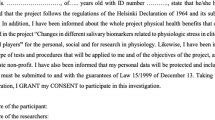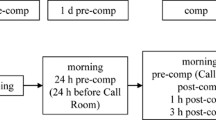Abstract
We have tested the hypothesis that salivary cortisol increases after a competitive training match in top-level male professional soccer players divided in team A (n = 11) versus team B (n = 11). Saliva samples collected before and after the match were analyzed. Salivary cortisol concentrations were measured by enzyme-linked immunosorbent assay. The results from a two-way ANOVA with repeated measures showed no significant changes in salivary cortisol between either teams or time points (P > 0.05). Further investigation regarding competitive matches in a competition environment is warranted. In summary, the influence of intensive competitive training match alone appears to be minimal on salivary cortisol changes in top-level soccer adapted to this type of stress. From a practical application, the variability of the responses among the players leads us to suggest that there is a need to individually analyse the results with team sports.
Similar content being viewed by others
References
Bangsbo J (1994) The physiology of soccer with special reference to intense intermittent exercise. Acta Physiol Scand Suppl 619:1–155
Carli G, Bonifazi M, Lodi L, Lupo C, Martelli G, Viti A (1986) Hormonal and metabolic effects following a football match. Int J Sports Med 7:36–38. doi:10.1055/s-2008-1025732
Dallman MF, Akana SF, Levin N, Walker CD, Bradbury MJ, Suemaru S et al (1994) Corticosteroids and the control of function in the hypothalamo-pituitary-adrenal (HPA) axis. Ann N Y Acad Sci 746:22–31
Doan BK, Newton RU, Kraemer WJ, Kwon YH, Scheet TP (2007) Salivary cortisol, testosterone, and T/C ratio responses during a 36-hole golf competition. Int J Sports Med 28:470–479. doi:10.1055/s-2006-924557
Elloumi M, Maso F, Michaux O, Robert A, Lac G (2003) Behaviour of saliva cortisol [C], testosterone [T] and the T/C ratio during a rugby match and during the post-competition recovery days. Eur J Appl Physiol 90:23–28. doi:10.1007/s00421-003-0868-5
Filaire E, Le Scanff C, Duche P, Lac G (1999) The relationship between salivary adrenocortical hormones changes and personality in elite female athletes during handball and volleyball competition. Res Q Exerc Sport 70:297–302
Greig MP, Mcnaughton LR, Lovell RJ (2006) Physiological and mechanical response to soccer-specific intermittent activity and steady-state activity. Res Sports Med 14:29–52. doi:10.1080/15438620500528257
Gura T (2008) Just spit it out. Nat Med 14:706–709. doi:10.1038/nm0708-706
Haneishi K, Fry AC, Moore CA, Schilling BK, Li Y, Fry MD (2007) Cortisol and stress responses during a game and practice in female collegiate soccer players. J Strength Cond Res 21:583–588. doi:10.1519/R-20496.1
Hetzler RK, Seip RL, Boutcher SH, Pierce E, Snead D, Weltman A (1991) Effect of exercise modality on ratings of perceived exertion at various lactate concentration. Med Sci Sports Exerc 23:88–92. doi:10.1249/00005768-199101000-00014
Irving BA, Rutkowski J, Brock DW, Davis CK, Barrett EJ, Gaesser GA et al (2006) Comparison of Borg- and OMNI-RPE as markers of the blood lactate response to exercise. Med Sci Sports Exerc 38:1348–1352. doi:10.1249/01.mss.0000227322.61964.d2
Ispirlidis I, Fatouros IG, Jamurtas AZ, Nikolaidis MG, Michailidis I, Douroudos I et al (2008) Time-course of changes in inflammatory and performance responses following a soccer game. Clin J Sport Med 18:423–431. doi:10.1097/JSM.0b013e3181818e0b
Judelson DA, Maresh CM, Yamamoto LM, Farrell MJ, Armstrong LE, Kraemer WJ et al (2008) Effect of hydration state on resistance exercise-induced endocrine markers of anabolism, catabolism, and metabolism. J Appl Physiol 105:816–824. doi:10.1152/japplphysiol.01010.2007
Lac G, Lac N, Robert A (1993) Steroid assays in saliva: a method to detect plasmatic contaminations. Arch Int Physiol Biochim Biophys 101:257–262. doi:10.3109/13813459309003921
Lehmann M, Foster C, Dickhuth HH, Gastmann U (1998) Autonomic imbalance hypothesis and overtraining syndrome. Med Sci Sports Exerc 30:1140–1145. doi:10.1097/00005768-199807000-00019
Mallo J, Navarro E (2008) Physical load imposed on soccer players during small-sided training games. J Sports Med Phys Fitness 48:166–171
Moreira A, Arsati F, Cury PR, Franciscon C, Simoes AC, de Oliveira PR, de Araújo VC (2008) The impact of a 17-day training period for an international championship on mucosal immune parameters in top-level basketball players and staff members. Eur J Oral Sci 116:431–437. doi:10.1111/j.1600-0722.2008.00558.x
Moreira A, Arsati F, Cury PR, Franciscon C, de Oliveira PR, de Araújo VC (2009) Salivary immunoglobulin A response to a match in top-level Brazilian soccer players. J Strength Cond Res (in press)
Murase Y, Kamei S, Hoshikawa T (1989) Heart rate and metabolic responses to participation in golf. J Sports Med Phys Fitness 29:269–272
Passelergue P, Lac G (1999) Saliva cortisol, testosterone and T/C ratio variations during a wrestling competition and during the post-competitive recovery period. Int J Sports Med 20:109–113
Rietjens GJ, Kuipers H, Adam JJ, Saris WH, Van Breda E, Van Hamont D et al (2005) Physiological, biochemical and psychological markers of strenuous training-induced fatigue. Int J Sports Med 26:16–26. doi:10.1055/s-2004-817914
Sari-Sarraf V, Reilly T, Doran D, Atkinson G (2008) Effects of repeated bouts of soccer-specific intermittent exercise on salivary IgA. Int J Sports Med 29:366–371. doi:10.1055/s-2007-965427
Seip RL, Snead D, Pierce F, Stein P, Weltman A (1991) Perceptual responses and blood lactate concentration: effect of training state. Med Sci Sports Exerc 23:80–87. doi:10.1249/00005768-199101000-00013
Smith DJ (2003) A framework for understanding the training process leading to elite performance. Sports Med 33:1103–1126. doi:10.2165/00007256-200333150-00003
Vining RF, Mcginley RA, Maksvytis JJ, Ho KY (1983) Salivary cortisol: a better measure of adrenal cortical function than serum cortisol. Ann Clin Biochem 20:329–335
Viru A, Karelson K, Smirnova T (1992) Stability and variability in hormonal responses to prolonged exercise. Int J Sports Med 13:230–235. doi:10.1055/s-2007-1021259
Whitehead R, Wilson Butz J, Kozar B, Vaughn RE (1996) Stress and performance: an application of Gray’s three-factor arousal theory to basketball free-throw shooting. J Sports Sci 14:393–401. doi:10.1080/02640419608727726
Author information
Authors and Affiliations
Corresponding author
Rights and permissions
About this article
Cite this article
Moreira, A., Arsati, F., de Oliveira Lima Arsati, Y.B. et al. Salivary cortisol in top-level professional soccer players. Eur J Appl Physiol 106, 25–30 (2009). https://doi.org/10.1007/s00421-009-0984-y
Accepted:
Published:
Issue Date:
DOI: https://doi.org/10.1007/s00421-009-0984-y




